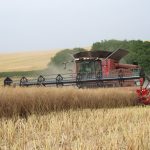As combines take to the fields up and down the UK to bring in the harvest, farmers need clarity on true costs and best use of their machines. Valuable pointers on where and how to save money have been shared with the JVFG member businesses by the group consultant Jamie Gwatkin for Harvest 2018 and beyond. This is a summary of his main points for intelligent combine harvester management.
Appreciating depreciation
“The largest cost element in combine harvesters is their depreciation. I am seeing that the response from member businesses is to run the combine over a seven year period rather than five – and to maintain them carefully to last that extra period. That is a big factor in reducing the depreciation costs in the final two years. Putting the purchase on a five year hire purchase agreement and then have two year’s ‘free’ use when it ends is another strategy.
DIY maintenance: worth it?
The second aspect to look at is the maintenance of combines. The consensus is that maintenance agreements from vendors are now too expensive. A preferable option is to get an agreement with a trained maintenance professional, who works independently but has all the training, knowledge and software to provide a good service to the business. Within JVFG, the most efficient business use of combine is by Granta Farming in Essex. This is a business that has never taken out any maintenance agreement with a supplier because they believe that they can do it themselves, for less cost, and still have the reliability they require.
Another factor is how many hectares you need to put through a combine for it to be a cost-effective component of the farm machinery fleet. JVFG figures show that it needs to be 1000ha.
My analysis shows that the most efficient combine use is by Granta Farming. They put about 1000 ha a year through their machine. In 2017 that dipped a little but good combine management had been used again: with an outlying 50 ha field still to cut the decision was taken that it was more cost effective to use a contractor to bring in the grain rather than to take the time and trouble to get their own machine all the way over to do it.
Benchmarking combine harvesters
Using John Nix average combine performance, members know they need to get below that UK standard in order to be cost effective. Analysing the combine usage by JVFG member businesses is showing up clear differences in performance. For example, Brixworth Farming has two combine teams working in parallel. Data from 2014 and 2015 shows that one performed much better than the other. The differential, as noted by Managing Director Charles Matts, was down to the driver operator. Lower performance was from the part-time contract driver. Meanwhile the employed worker got much better productivity from the machine.This shows the importance of the driver is absolutely paramount. Getting and understanding the evidence has enabled Brixworth Farming to make a change and now they can see that their combine costs are back on the right track.
Finally, JVFG data is helping businesses to decided how many combines to run. The figures for Stoke Farm has helped them to make the decision to go from two combines (one of which only covered 400ha) down to one.”



